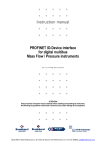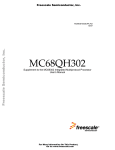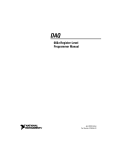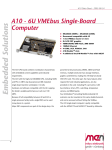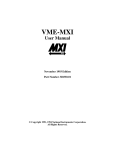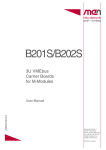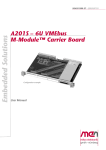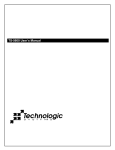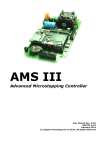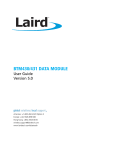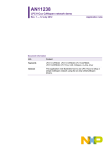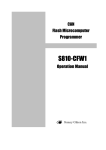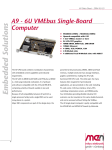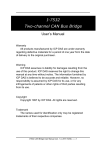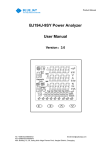Download 20A203N00 E2 User Manual
Transcript
20A203N00 E2 – 2014-01-21
User Manual
A203N - 6U VME64
M-Module™ Carrier
Board
Configuration example
A203N - 6U VME64 M-Module™ Carrier Board
A203N - 6U VME64 M-Module™ Carrier Board
The A203N is an M-Module™ carrier board for universal I/O on the VMEbus,
allowing high flexibility in applications such as process and motion control,
measurement and instrumentation, communication or special-purpose tasks. The MModules™ are screwed tightly on the carrier board, and the board needs only one
slot on the VMEbus.
The A203N is a VME64 slave card and supports four D16/D32 M-Modules™ with
the signals either at the front or via rear I/O. An interrupt controller handles the MModules™ individually.
For rugged requirements the A203N is equipped with a stiffener front panel, allows
a standard -40 to +85°C operation temperature and is prepared for conformal
coating.
Additionally, the A203N is prepared for DMA transfer support.
MEN Mikro Elektronik GmbH
20A203N00 E2 – 2014-01-21
2
Diagram
Diagram
F
M‐Module
VMEbus Interface/
Interrupt Controller
VMEbus
P1
F
M‐Module
F
M‐Module
Rear I/O
P2
F
M‐Module
MEN Mikro Elektronik GmbH
20A203N00 E2 – 2014-01-21
3
Technical Data
Technical Data
Mezzanine Slots
•
•
•
•
•
Four M-Module™ slots
Compliant with M-Module™ standard
Characteristics: D08, D16, D32, A08, A24, INTA, INTC, TRIGO, TRIGI
Prepared for DMA16, DMA32
Prepared for D16 burst, D32 burst
Interrupt Controller
• Interrupt handling individually for each M-Module™
Peripheral Connections
• Via front panel
• Via 160-pin P2 connector (rear I/O)
VMEbus
• Only one slot required on the VMEbus
• Slave
- D08(EO):D16:D32:A16:A24:A32;BLT, prepared for D16BLT and D32BLT
• Interrupter D08(O):I(7-1)
Electrical Specifications
• Supply voltage/power consumption: +5V (-3%/+5%), typ. 140mA (without MModules™)
• MTBF: 274,000h @ 40°C (derived from MIL-HDBK-217F)
Mechanical Specifications
• Dimensions: standard double Eurocard, 233.3mm x 160mm
• Front panel: stiffener panel, aluminum with 2 handles, cut-outs for front connectors of 4 M-Modules™
• Weight: 350g
MEN Mikro Elektronik GmbH
20A203N00 E2 – 2014-01-21
4
Technical Data
Environmental Specifications
• Temperature range (operation):
- -40..+85°C
- Airflow: min. 10m³/h
• Temperature range (storage): -40..+85°C
• Relative humidity range (operation): max. 95% without condensation
• Relative humidity range (storage): max. 95% without condensation
• Altitude: -300m to + 3,000m
• Shock: 15g/11ms
• Bump: 10g/16ms
• Vibration (sinusoidal): 2g/10..150Hz
• Conformal coating on request
Safety
• PCB manufactured with a flammability rating of 94V-0 by UL recognized manufacturers
EMC
• Tested according to EN 55022 (radio disturbance), IEC1000-4-2 (ESD) and
IEC1000-4-4 (burst)
Software Support
• M-Module™ drivers for Windows®, VxWorks®, Linux, QNX®, OS-9® as supported
• Basic board driver included in MDIS™ system package for the respective operating system
• For more information on supported operating system versions and drivers see
online data sheet.
MEN Mikro Elektronik GmbH
20A203N00 E2 – 2014-01-21
5
Product Safety
Product Safety
!
Electrostatic Discharge (ESD)
Computer boards and components contain electrostatic sensitive devices.
Electrostatic discharge (ESD) can damage components. To protect the board and
other components against damage from static electricity, you should follow some
precautions whenever you work on your computer.
• Power down and unplug your computer system when working on the inside.
• Hold components by the edges and try not to touch the IC chips, leads, or circuitry.
• Use a grounded wrist strap before handling computer components.
• Place components on a grounded antistatic pad or on the bag that came with the
component whenever the components are separated from the system.
• Store the board only in its original ESD-protected packaging. Retain the original
packaging in case you need to return the board to MEN for repair.
MEN Mikro Elektronik GmbH
20A203N00 E2 – 2014-01-21
6
About this Document
About this Document
This user manual is intended only for system developers and integrators, it is not
intended for end users.
It describes the hardware functions of the board, connection of peripheral devices
and integration into a system. It also provides additional information for special
applications and configurations of the board.
The manual does not include detailed information on individual components (data
sheets etc.). A list of literature is given in the appendix.
History
Issue
Comments
Date
E1
First issue
2006-10-19
E2
Changes made to Table 2. Extended address mode 2014-01-21
Conventions
This sign marks important notes or warnings concerning the use of voltages which
can lead to serious damage to your health and also cause damage or destruction of
the component.
!
italics
bold
monospace
This sign marks important notes or warnings concerning proper functionality of the
product described in this document. You should read them in any case.
Folder, file and function names are printed in italics.
Bold type is used for emphasis.
A monospaced font type is used for hexadecimal numbers, listings, C function
descriptions or wherever appropriate. Hexadecimal numbers are preceded by "0x".
comment
Comments embedded into coding examples are shown in green color.
hyperlink
Hyperlinks are printed in blue color.
The globe will show you where hyperlinks lead directly to the Internet, so you can
look for the latest information online.
IRQ#
/IRQ
Signal names followed by "#" or preceded by a slash ("/") indicate that this signal is
either active low or that it becomes active at a falling edge.
in/out
Signal directions in signal mnemonics tables generally refer to the corresponding
board or component, "in" meaning "to the board or component", "out" meaning
"coming from it".
Vertical lines on the outer margin signal technical changes to the previous issue of
the document.
MEN Mikro Elektronik GmbH
20A203N00 E2 – 2014-01-21
7
About this Document
Legal Information
Changes
MEN Mikro Elektronik GmbH ("MEN") reserves the right to make changes without further notice to any products
herein.
Warranty, Guarantee, Liability
MEN makes no warranty, representation or guarantee of any kind regarding the suitability of its products for any
particular purpose, nor does MEN assume any liability arising out of the application or use of any product or
circuit, and specifically disclaims any and all liability, including, without limitation, consequential or incidental
damages. TO THE EXTENT APPLICABLE, SPECIFICALLY EXCLUDED ARE ANY IMPLIED
WARRANTIES ARISING BY OPERATION OF LAW, CUSTOM OR USAGE, INCLUDING WITHOUT
LIMITATION, THE IMPLIED WARRANTIES OF MERCHANTABILITY AND FITNESS FOR A
PARTICULAR PURPOSE OR USE. In no event shall MEN be liable for more than the contract price for the
products in question. If buyer does not notify MEN in writing within the foregoing warranty period, MEN shall
have no liability or obligation to buyer hereunder.
The publication is provided on the terms and understanding that:
1. MEN is not responsible for the results of any actions taken on the basis of information in the publication, nor
for any error in or omission from the publication; and
2. MEN is not engaged in rendering technical or other advice or services.
MEN expressly disclaims all and any liability and responsibility to any person, whether a reader of the publication
or not, in respect of anything, and of the consequences of anything, done or omitted to be done by any such person
in reliance, whether wholly or partially, on the whole or any part of the contents of the publication.
Conditions for Use, Field of Application
The correct function of MEN products in mission-critical and life-critical applications is limited to the
environmental specification given for each product in the technical user manual. The correct function of MEN
products under extended environmental conditions is limited to the individual requirement specification and
subsequent validation documents for each product for the applicable use case and has to be agreed upon in writing
by MEN and the customer. Should the customer purchase or use MEN products for any unintended or
unauthorized application, the customer shall indemnify and hold MEN and its officers, employees, subsidiaries,
affiliates, and distributors harmless against all claims, costs, damages, and expenses, and reasonable attorney fees
arising out of, directly or indirectly, any claim or personal injury or death associated with such unintended or
unauthorized use, even if such claim alleges that MEN was negligent regarding the design or manufacture of the
part. In no case is MEN liable for the correct function of the technical installation where MEN products are a part
of.
Trademarks
All products or services mentioned in this publication are identified by the trademarks, service marks, or product
names as designated by the companies which market those products. The trademarks and registered trademarks
are held by the companies producing them. Inquiries concerning such trademarks should be made directly to those
companies.
Conformity
MEN products are no ready-made products for end users. They are tested according to the standards given in the
Technical Data and thus enable you to achieve certification of the product according to the standards applicable in
your field of application.
MEN Mikro Elektronik GmbH
20A203N00 E2 – 2014-01-21
8
About this Document
RoHS
Since July 1, 2006 all MEN standard products comply with RoHS legislation.
Since January 2005 the SMD and manual soldering processes at MEN have already been completely lead-free.
Between June 2004 and June 30, 2006 MEN’s selected component suppliers have changed delivery to RoHScompliant parts. During this period any change and status was traceable through the MEN ERP system and the
boards gradually became RoHS-compliant.
WEEE Application
The WEEE directive does not apply to fixed industrial plants and tools. The compliance is the responsibility of the
company which puts the product on the market, as defined in the directive; components and sub-assemblies are
not subject to product compliance.
In other words: Since MEN does not deliver ready-made products to end users, the WEEE directive is not
applicable for MEN. Users are nevertheless recommended to properly recycle all electronic boards which have
passed their life cycle.
Nevertheless, MEN is registered as a manufacturer in Germany. The registration number can be provided on
request.
Copyright © 2014 MEN Mikro Elektronik GmbH. All rights reserved.
Germany
MEN Mikro Elektronik GmbH
Neuwieder Straße 3-7
90411 Nuremberg
Phone +49-911-99 33 5-0
Fax +49-911-99 33 5-901
E-mail [email protected]
www.men.de
MEN Mikro Elektronik GmbH
20A203N00 E2 – 2014-01-21
France
MEN Mikro Elektronik SA
18, rue René Cassin
ZA de la Châtelaine
74240 Gaillard
Phone +33 (0) 450-955-312
Fax +33 (0) 450-955-211
E-mail [email protected]
www.men-france.fr
USA
MEN Micro Inc.
860 Penllyn Blue Bell Pike
Blue Bell, PA 19422
Phone (215) 542-9575
Fax (215) 542-9577
E-mail [email protected]
www.menmicro.com
9
Contents
Contents
1 Getting Started . . . . . . . . . . . . . . . . . . . . . . . . . . . . . . . . . . . . . . . . . . . . . . . .
1.1 Map of the Board. . . . . . . . . . . . . . . . . . . . . . . . . . . . . . . . . . . . . . . . .
1.2 Integrating the Board into a System . . . . . . . . . . . . . . . . . . . . . . . . . .
1.3 Installing M-Modules . . . . . . . . . . . . . . . . . . . . . . . . . . . . . . . . . . . . .
1.4 Installing Driver Software . . . . . . . . . . . . . . . . . . . . . . . . . . . . . . . . . .
13
13
14
15
15
2 Address Organization . . . . . . . . . . . . . . . . . . . . . . . . . . . . . . . . . . . . . . . . . . . 16
3 Functional Description . . . . . . . . . . . . . . . . . . . . . . . . . . . . . . . . . . . . . . . . . .
3.1 Power Supply. . . . . . . . . . . . . . . . . . . . . . . . . . . . . . . . . . . . . . . . . . . .
3.2 VMEbus Interface . . . . . . . . . . . . . . . . . . . . . . . . . . . . . . . . . . . . . . . .
3.2.1
Slave Interface. . . . . . . . . . . . . . . . . . . . . . . . . . . . . . . . . . . .
3.2.2
VMEbus Connectors P1 and P2 . . . . . . . . . . . . . . . . . . . . . .
3.3 M-Module Interfaces . . . . . . . . . . . . . . . . . . . . . . . . . . . . . . . . . . . . . .
3.3.1
M-Module Connector . . . . . . . . . . . . . . . . . . . . . . . . . . . . . .
3.3.2
M-Module Access . . . . . . . . . . . . . . . . . . . . . . . . . . . . . . . . .
3.4 Interrupt Controller . . . . . . . . . . . . . . . . . . . . . . . . . . . . . . . . . . . . . . .
3.4.1
Interrupt Registers. . . . . . . . . . . . . . . . . . . . . . . . . . . . . . . . .
3.5 Trigger Logic . . . . . . . . . . . . . . . . . . . . . . . . . . . . . . . . . . . . . . . . . . . .
3.6 Revision Register. . . . . . . . . . . . . . . . . . . . . . . . . . . . . . . . . . . . . . . . .
3.7 Temperature Sensor . . . . . . . . . . . . . . . . . . . . . . . . . . . . . . . . . . . . . . .
3.8 FPGA Configuration . . . . . . . . . . . . . . . . . . . . . . . . . . . . . . . . . . . . . .
19
19
19
19
21
25
25
26
27
27
29
30
30
31
4 Appendix . . . . . . . . . . . . . . . . . . . . . . . . . . . . . . . . . . . . . . . . . . . . . . . . . . . . . 32
4.1 Literature and Web Resources . . . . . . . . . . . . . . . . . . . . . . . . . . . . . . . 32
MEN Mikro Elektronik GmbH
20A203N00 E2 – 2014-01-21
10
Figures
Figure 1. Map of the board – front panel and top view . . . . . . . . . . . . . . . . . . . . 13
Figure 2. Address selection using rotary hex switches . . . . . . . . . . . . . . . . . . . . 20
MEN Mikro Elektronik GmbH
20A203N00 E2 – 2014-01-21
11
Tables
Table 1.
Table 2.
Table 3.
Table 4.
Table 5.
Table 6.
Table 7.
MEN Mikro Elektronik GmbH
20A203N00 E2 – 2014-01-21
Address map for normal mode (A16 and A24) . . . . . . . . . . . . . . . . . .
Extended address mode (VMEbus A32) . . . . . . . . . . . . . . . . . . . . . . .
Address modifier codes permitted on A203N . . . . . . . . . . . . . . . . . . .
Pin assignment of VME64 connector P1 . . . . . . . . . . . . . . . . . . . . . . .
Pin assignment of VME64 connector P2 . . . . . . . . . . . . . . . . . . . . . . .
Signal mnemonics of VMEbus connector P2. . . . . . . . . . . . . . . . . . . .
Pin assignment of the 60-pin plug connectors . . . . . . . . . . . . . . . . . . .
16
18
21
22
23
24
25
12
Getting Started
1
Getting Started
This chapter gives an overview of the board and some hints for first installation in a
system.
1.1
Map of the Board
60‐pin
M‐Module Bus
Connector
24‐pin
Connector
M‐Module 2
60‐pin
M‐Module Bus
Connector
MEN Mikro Elektronik GmbH
20A203N00 E2 – 2014-01-21
0
4
8
0
C
4
8
0
C
4
Hex Switches
C
8
24‐pin
Connector
M‐Module 1
60‐pin
M‐Module Bus
Connector
24‐pin
Connector
M‐Module 0
60‐pin
M‐Module Bus
Connector
VMEbus P2
M‐Module 0
Front‐panel mounting screws (accessible from bottom side of board)
VMEbus P1
M‐Module 3
M‐Module 3
M‐Module 1
24‐pin
Connector
M‐Module 2
Figure 1. Map of the board – front panel and top view
13
Getting Started
1.2
Integrating the Board into a System
You can use the following hints to install the carrier board into a VMEbus system
for the first time and to test proper functioning of the board.
The A203N has an A24/D16/D32 or A16/D16/D32 VMEbus slave interface. If it is
required for the board to issue an interrupt via the bus, then the daisy chain must be
established through to the A203N.
!
The carrier board is completely trimmed on delivery. Perform the following
procedure without an M-Module installed!
Power-down the system.
The board is set for A24 accesses, the base address being 0xE00000. This
base address is set using rotary hex switches. It may be necessary to set it to an
address with which the master can access the board in A24/D16 mode.
(If you have to change the base address, please refer to Chapter 3.2.1.1 Setting
the Base Address on page 20.)
Insert the A203N into your VMEbus system, making sure that the VMEbus
connectors are properly aligned.
Power-up the system.
After power-up, load a suitable debugger.
First, attempt to perform a read-word access to the base address plus 0x100,
(i.e. 0xE00100 if the base address was not altered).
With 32-bit masters it may be necessary to load a register on the master board
to set the access mode. In any case you should be aware of the contents of the
high-order byte of the 32-bit address. For instance, access may require using
address 0xFFE00100 or 0xFCE00100 or any other address (depends on the
master board).
If a bus error occurs while you are attempting to read, check if the base address
is set correctly and whether it is possible for the master to access the VMEbus
at all at the selected address and using the correct mode. Then try again.
Now attempt to perform a word access to the base address plus 0x102. Again,
no bus error should occur. Write accesses to this memory location should be
successful for the right half of the word. For instance, if 0x55 is written to the
register it should be possible to read 0xxx55.
You must have completed this test successfully before you begin to integrate an
M-Module into the system (see Chapter 1.3 Installing M-Modules on page 15
and description in the respective M-Module user manual).
Note: Interrupts cannot be tested in this simple fashion.
MEN Mikro Elektronik GmbH
20A203N00 E2 – 2014-01-21
14
Getting Started
1.3
Installing M-Modules
Perform the following steps to install an M-Module:
Loosen the two front-panel mounting screws at the solder side of the A203N
and remove the whole front panel (see Figure 1, Map of the board – front panel
and top view, on page 13).
Hold the M-Module over the target slot of the A203N with the component sides
facing each other.
Align the 24-pin and 60-pin connectors of the M-Module and carrier board.
Press the M-Module carefully but firmly on the A203N, making sure that the
connectors are properly linked.
Turn the A203N upside down and use four M-Module mounting screws to fasten the M-Module on the solder side of the A203N.
Re-install the front panel of the A203N.
!
!
Note: You can order suitable mounting screws from MEN, see MEN’s website. In
any case, use only the screw types specified in the following figure!
Note: Older M-Modules with a solder side cover may collide with the front panel. If
you have any problems, please contact MEN’s technical support:
[email protected].
M‐Module
Mounting Bolt
24‐pin connector
60‐pin connector
A203N without front panel
M3x6 cross‐recess pan‐head screws
1.4
M3x6 slotted pan‐head screws (plastics)
Installing Driver Software
For a detailed description on how to install driver software please refer to the
respective documentation.
You can find any driver software available for download on MEN’s website.
MEN Mikro Elektronik GmbH
20A203N00 E2 – 2014-01-21
15
Address Organization
2
Address Organization
The A203N can be accessed via VMEbus in A16, A24 or A32 mode. The address
windows provide access to internal registers and the M-Module address spaces.
Note: The registers underlaid in gray in the table below exist once but can be accessed
at more than one address
Table 1. Address map for normal mode (A16 and A24)
Offset
Address
M-Module
VMEbus Data
Access Type
0x000..
0x0FF
M-Module Access
A08/D16/D32
0
Depending on
M-Module:
D08, D16, D32
0x101
M-Module Interrupt Control
Register
0
D08, D16
0x103
M-Module Interrupt Vector
Register
0
D08, D16
0x107
reserved
0
0x181
Trigger Data Register
-
D08, D16
0x183
Trigger Direction Register
-
D08, D16
0x203
reserved
0
0x280..
0x28B
reserved
0
0x290..
0x29B
reserved
0
0x301
Revision
-
D08, D16
0x303
A32 Slave Address Compare
Register
-
D08, D16
0x381
Temperature Sensor Register
-
D08, D16
0x3A0
Flash Address Register
0
D08, D16, D32
0x3A4
Flash Data Register
0
0x400..
0x4FF
M-Module Access
A08/D16/D32
1
Depending on
M-Module:
D08, D16, D32
0x501
M-Module Interrupt Control
Register
1
D08, D16
0x503
M-Module Interrupt Vector
Register
1
D08, D16
0x507
reserved
1
0x581
Trigger Data Register
-
D08, D16
0x583
Trigger Direction Register
-
D08, D16
0x603
reserved
1
MEN Mikro Elektronik GmbH
20A203N00 E2 – 2014-01-21
Function
16
Address Organization
Offset
Address
M-Module
VMEbus Data
Access Type
0x680..
0x68B
reserved
1
0x690..
0x69B
reserved
1
0x701
Revision
-
D08, D16
0x703
A32 Slave Address Compare
Register
-
D08, D16
0x781
Temperature Sensor Register
-
D08, D16
0x7A0
Flash Address Register
0
D08, D16, D32
0x7A4
Flash Data Register
0
D08, D16, D32
0x800..
0x8FF
M-Module Access
A08/D16/D32
2
Depending on
M-Module:
D08, D16, D32
0x901
M-Module Interrupt Control
Register
2
D08, D16
0x903
M-Module Interrupt Vector
Register
2
D08, D16
0x907
reserved
2
0x981
Trigger Data Register
-
D08, D16
0x983
Trigger Direction Register
-
D08, D16
0xA03
reserved
2
0xA80..
0xA8B
reserved
2
0xA90..
0xA9B
reserved
2
0xB01
Revision
-
D08, D16
0xB03
A32 Slave Address Compare
Register
-
D08, D16
0xB81
Temperature Sensor Register
-
D08, D16
0xBA0
Flash Address Register
0
D08, D16, D32
0xBA4
Flash Data Register
0
D08, D16, D32
0xC00..
0xCFF
M-Module Access
A08/D16/D32
3
Depending on
M-Module:
D08, D16, D32
0xD01
M-Module Interrupt Control
Register
3
D08, D16
0xD03
M-Module Interrupt Vector
Register
3
D08, D16
0xD07
reserved
3
MEN Mikro Elektronik GmbH
20A203N00 E2 – 2014-01-21
Function
17
Address Organization
Offset
Address
Function
M-Module
VMEbus Data
Access Type
0xD81
Trigger Data Register
-
D08, D16
0xD83
Trigger Direction Register
-
D08, D16
0xE03
reserved
3
0xE80..
0xE8B
reserved
3
0xE90..
0xE9B
reserved
3
0xF01
Revision
-
D08, D16
0xF03
A32 Slave Address Compare
Register
-
D08, D16
0xF81
Temperature Sensor Register
-
D08, D16
0xFA0
Flash Address Register
0
D08, D16, D32
0xFA4
Flash Data Register
0
D08, D16, D32
The base address for the above table is set using rotary hex switches. Depending on
a jumper you can access the A08 address area of the M-Modules from the VMEbus
in A16 (short) or A24 (standard) mode. The A203N supports A24 accesses to the
M-Modules.
For the four modules a memory area of 0x4000000 bytes is necessary – this large
area can be addressed from the VMEbus in A32 mode. The base address can be
loaded by software into a register so that no additional hex switch is needed to set it.
In extended address mode the following mapping is valid:
Table 2. Extended address mode (VMEbus A32)
Offset
Address
M-Module
VMEbus Data
Access Type
0x0000000..
0x0FFFFFF
M-Module Access
A24/D16/D32
0
Depending on
M-Module:
D08, D16, D32
0x1000000..
0x1FFFFFF
M-Module Access
A24/D16/D32
1
Depending on
M-Module:
D08, D16, D32
0x2000000..
0x2FFFFFF
M-Module Access
A24/D16/D32
2
Depending on
M-Module:
D08, D16, D32
0x3000000..
0x3FFFFFF
M-Module Access
A24/D16/D32
3
Depending on
M-Module:
D08, D16, D32
MEN Mikro Elektronik GmbH
20A203N00 E2 – 2014-01-21
Function
18
Functional Description
3
Functional Description
3.1
Power Supply
Power supply to the logic part is done via the VMEbus connector P1. The necessary
voltage is +5V.
For power supply to the logic part the necessary voltages are 3.3V and 1.2V.
3.2
VMEbus Interface
3.2.1
Slave Interface
In short (A16) and standard (A24) mode the A203N occupies an address space of
0x1000 bytes on the VMEbus . These 0x1000 bytes are divided into 4 identical
parts. Each 0x400 byte part is assigned to one M-Module slot. 0x100 bytes are
used for addressing the module in A08 mode. The remaining 0x300 bytes for each
module slot are used to address the interrupt controller. This means that each MModule on the A203N has the same address mapping. This greatly facilitates
writing software since it is only necessary to take into account the base address of
the module, and not the base address of the base board as well. Each module has its
own interrupt vector register and its own control register.
In extended mode (A32) the A203N occupies an address space of 0x4000000 bytes
on the VMEbus .
The VMEbus interface supports the following features:
• Slave: A32, A24, A16, D32, D16, D08(EO), D16BLT, D32BLT, D64BLT
• 7-level D08 (O) interrupter, mechanism ROAK and RORA
Note: The board is prepared for DMA accesses.
MEN Mikro Elektronik GmbH
20A203N00 E2 – 2014-01-21
19
Functional Description
3.2.1.1
Setting the Base Address
In A16 or A24 VMEbus mode the A203N occupies an area of 0x1000 bytes in the
address space. The base address is set using one (A16 mode) or three (A24 mode)
rotary hex switches. A jumper defines whether the board is operated in A16 or in
A24 mode.
Figure 2. Address selection using rotary hex switches
J1 installed
J1 removed
4
4
8
0
C
C
4
C
4
4
8
0
8
0
C
Not needed
A
4
8
0
8
0
A
C
example:
A16 address mode
base address 0xA000
1
0
8
C
example:
A24 address mode
base address 0x10A000
In the A32 address space the board occupies 0x4000000 bytes. In this case the base
address is set through software by accessing the A32 Slave Address Compare
Register. After reset no access is possible in A32 mode first.
MEN Mikro Elektronik GmbH
20A203N00 E2 – 2014-01-21
20
Functional Description
3.2.1.2
Address Modifiers
The VMEbus has 6 address modifier lines. These lines allow the master to transfer
additional binary information to the slave during a data transfer cycle. The lines are
used to divide the address space of the VMEbus into several classes. The following
codes are permitted for the A203N:
Table 3. Address modifier codes permitted on A203N
HEX
Code
AM
Function
Comment
5
4
3
2
1
0
0x29,
0x2D
H
L
H
X
L
H Short supervisory and
non-privileged data
access
J1 installed
0x39,
0x3B,
0x3D,
0x3F
H H H
X
L
H Standard supervisory
and non-privileged data
access
J1 removed
0x09,
0x0B,
0x0D,
0x0F
H
X
X
H Extended supervisory
and nonprivileged data
access, block transfer
Enabled through
software (write
access to A32BASE enables A32)
3.2.2
L
H
VMEbus Connectors P1 and P2
Connector types:
• 160-pin, 5-row plug, performance level according to DIN41612, part 5
• Mating connector:
160-pin, 5-row receptacle, performance level according to DIN41612, part 5
The pin assignment of P1 conforms to the VME64 specification VITA 1-1994 and
VME64 Extensions Draft Standard VITA 1.1-199x.
MEN Mikro Elektronik GmbH
20A203N00 E2 – 2014-01-21
21
Functional Description
Table 4. Pin assignment of VME64 connector P1
ZABCD
1
32
Z
A
B
C
D
1
-
D0
/BBSY
D8
-
2
GND
D1
-
D9
GND
3
-
D2
-
D10
-
4
GND
D3
-
D11
-
5
-
D4
-
D12
-
6
GND
D5
-
D13
-
7
-
D6
-
D14
-
8
GND
D7
-
D15
-
9
-
GND
-
GND
-
10
GND
SYSCLK
/BG3IN
/SYSFAIL
-
11
-
GND
/BG3OUT
/BERR
-
12
GND
/DS1
/BR0
/SYSRESET
-
13
-
/DS0
/BR1
/LWORD
-
14
GND
/WRITE
/BR2
AM5
-
15
-
GND
/BR3
A23
-
16
GND
/DTACK
AM0
A22
-
17
-
GND
AM1
A21
-
18
GND
/AS
AM2
A20
-
19
-
GND
AM3
A19
-
20
GND
/IACK
GND
A18
-
21
-
/IACKIN
-
A17
-
22
GND
/IACKOUT
-
A16
-
23
-
AM4
GND
A15
-
24
GND
A7
/IRQ7
A14
-
25
-
A6
/IRQ6
A13
-
26
GND
A5
/IRQ5
A12
-
27
-
A4
/IRQ4
A11
-
28
GND
A3
/IRQ3
A10
-
29
-
A2
/IRQ2
A9
-
30
GND
A1
/IRQ1
A8
-
31
-
-12V
-
+12V
-
32
GND
+5V
+5V
+5V
-
MEN Mikro Elektronik GmbH
20A203N00 E2 – 2014-01-21
22
Functional Description
Table 5. Pin assignment of VME64 connector P2
ZABCD
1
32
Z
A
B
C
D
1
-
MOD2-2
+5V
MOD2-1
MOD3-1
2
GND
MOD2-4
GND
MOD2-3
MOD3-2
3
-
MOD2-6
-
MOD2-5
MOD3-3
4
GND
MOD2-8
A24
MOD2-7
MOD3-4
5
MOD2-22
MOD2-10
A25
MOD2-9
MOD3-5
6
GND
MOD2-12
A26
MOD2-11
MOD3-6
7
MOD2-23
MOD2-14
A27
MOD2-13
MOD3-7
8
GND
MOD2-16
A28
MOD2-15
MOD3-8
9
MOD2-24
MOD2-18
A29
MOD2-17
MOD3-9
10
GND
MOD2-20
A30
MOD2-19
MOD3-10
11
-
MOD1-1
A31
MOD2-21
MOD3-11
12
GND
MOD1-3
GND
MOD1-2
MOD3-12
13
-
MOD1-5
+5V
MOD1-4
MOD3-13
14
GND
MOD1-7
D16
MOD1-6
MOD3-14
15
-
MOD1-9
D17
MOD1-8
MOD3-15
16
GND
MOD1-11
D18
MOD1-10
MOD3-16
17
MOD1-22
MOD1-13
D19
MOD1-12
MOD3-17
18
GND
MOD1-15
D20
MOD1-14
MOD3-18
19
MOD1-23
MOD1-17
D21
MOD1-16
MOD3-19
20
GND
MOD1-19
D22
MOD1-18
MOD3-20
21
MOD1-24
MOD1-21
D23
MOD1-20
MOD3-21
22
GND
MOD0-2
GND
MOD0-1
MOD3-22
23
-
MOD0-4
D24
MOD0-3
MOD3-23
24
GND
MOD0-6
D25
MOD0-5
MOD3-24
25
-
MOD0-8
D26
MOD0-7
-
26
GND
MOD0-10
D27
MOD0-9
-
27
-
MOD0-12
D28
MOD0-11
-
28
GND
MOD0-14
D29
MOD0-13
-
29
MOD0-23
MOD0-16
D30
MOD0-15
-
30
GND
MOD0-18
D31
MOD0-17
+5V
31
MOD0-24
MOD0-20
GND
MOD0-19
GND
32
GND
MOD0-22
+5V
MOD0-21
-
MEN Mikro Elektronik GmbH
20A203N00 E2 – 2014-01-21
23
Functional Description
Table 6. Signal mnemonics of VMEbus connector P2
Signal
Function
+5V
-
+5V power supply
GND
-
Digital ground
A[31:24]
in
VME64 address lines
D[31:16]
in/out
VME64 data lines
MODy-xx
in/out
Signal xx from M-Module y 24-pin rear I/O connector
MEN Mikro Elektronik GmbH
20A203N00 E2 – 2014-01-21
Direction
24
Functional Description
3.3
M-Module Interfaces
A total of four M-Modules can be installed on the A203N. Peripheral equipment
may be connected at the front using the M-Module’s front connector or at the rear
using the carrier board’s second VMEbus connector (P2).
3.3.1
M-Module Connector
The signals from the base board are fed to the module via a 60-pin plug connector.
This plug connector corresponds to the three-row receptacle connector on the
module. However, the A203N also supports M-Modules with two-row 40-pin
connectors.
Table 7. Pin assignment of the 60-pin plug connectors
A
B
A
B
C
1
/CS
GND
/AS
2
A01
+5V
D16
3
A02
+12V
D17
4
A03
-12V
D18
5
A04
GND
D19
6
A05
/DREQ
D20
7
A06
/DACK
D21
8
A07
GND
D22
9
D08/A16
D00/A08
TRIGA
10
D09/A17
D01/A09
TRIGB
11
D10/A18
D02/A10
D23
12
D11/A19
D03/A11
D24
13
D12/A20
D04/A12
D25
14
D13/A21
D05/A13
D26
15
D14/A22
D06/A14
D27
16
D15/A23
D07/A15
D28
17
/DS1
/DS0
D29
18
/DTACK
/WRITE
D30
19
/IACK
/IRQ
D31
20
/RESET
SYSCLK
/DS2
C
1
20
Connector types:
• Three 20-pin plugs, 2.54mm pitch, square pins 0.635mm gold
• Mating connector:
Three 20-pin receptacles, high-precision, 2.54mm pitch, for square pins
0.635mm gold, 6.9mm height
MEN Mikro Elektronik GmbH
20A203N00 E2 – 2014-01-21
25
Functional Description
3.3.2
M-Module Access
The VMEbus slave interface of the A203N allows access to the M-Modules in A08
and A24 M-Module address space.
The M-Module address space (A08 or A24) which will be accessed is determined
by the VMEbus address modifiers. If you do an access from the VMEbus in A16
(short) or A24 (standard) mode, the M-Module is accessed in the A08 M-Module
address space. The A32 mode (extended) of the VMEbus results in an A24 access to
the M-Module. Block transfers from the VMEbus are converted to D16/D32 single
cycles to the M-Module. VMEbus 256-byte boundary crossing is not supported.
The base address for short and standard mode is set using rotary hex switches as
described above. The base address for extended access is programmed in a register.
A32 Base Address Register (0x303, 0x703, 0xB03, 0xF03) (read/write)
15..8
7..4
3..0
-
BASE32
reserved
Default Value: 0x0000
BASE32
Base address for A32 slave window (A31..A28)
All combinations are supported
The A32 mode can be activated by a write access and cannot be de-activated by a
write access but only by reset.
The base address base of an M-Module is calculated by the formula
base = A203Nbase + modslot 0x1000000
base
M-Module base address
A203Nbase Base address of A203N
modslot
M-Module slot number on A203N
For every module in A24 mode an address space of 16MB is provided.
The M-Module interface supports the following features:
•
•
•
•
•
•
•
•
4 M-Module Slots
MA interface
A08, A24
D08, D16, D32
INTA, INTC
Prepared for DMA16, DMA32
TRIGO, TRIGI
Prepared for D16 burst, D32 burst
MEN Mikro Elektronik GmbH
20A203N00 E2 – 2014-01-21
26
Functional Description
3.4
Interrupt Controller
The interrupter has been implemented using a glue logic chip. This chip handles
local interrupt sources with the VMEbus. It supports all signals used for the
VMEbus interrupt protocol. Interrupt vectors from the local source of the interrupt
can be passed on, and the chip also provides the capability of passing a
preprogrammed vector. Eight internal registers (four status registers and four vector
registers) are provided for general use.
The A203N supports all interrupt lines IRQ1 to IRQ7.
3.4.1
Interrupt Registers
The interrupt controller contains 12 programmable write-read registers. The four
control registers control the activity of the chip, the other eight are the vector
registers, which contain the vector information for the IACK cycle. A set of three
registers is allocated to each module.
Interrupt Control Register (0x101, 0x501, 0x901, 0xD01) (read/write)
15..8
7
6
5
4
3
-
IPEND
-
X/IN
IRE
IRAC
2
1
0
IRQ_LEVEL
Default Value: 0x0000
IPEND
Pending interrupt from M-Module
This bit is set if the M-Module generates the interrupt. The bit must
be cleared by writing '1' to the register during the interrupt service
routine to release the corresponding interrupt line on the VMEbus.
0 = No interrupt generated
1 = M-Module interrupt generated
X/IN
External/internal IACK cycle
0 = Interrupt ID vector from interrupt vector register will be used
for VME IACK cycle
1 = VME IACK cycle will be routed to M-Module IACK cycle
IRE
Interrupt enable
This bit must be '1' to allow an interrupt to be generated at all. If this
bit is '0', no interrupt is triggered on the VMEbus – even though an
interrupt from the module is pending.
0 = Interrupt disabled
1 = Interrupt enabled (activates interrupt line on VMEbus on
interrupt level when IPEND = 1)
IRAC
Interrupt enable auto clear
0 = IRE bit remains unchanged
1 = Clears IRE bit upon IACK cycle independent of X/IN
(Interrupt request from M-Module and IPEND bit must be
cleared additionally to prepare for the next interrupt)
MEN Mikro Elektronik GmbH
20A203N00 E2 – 2014-01-21
27
Functional Description
IRQ_LEVEL Interrupt level on VME bus (no other levels are supported)
001 = IRQ Level 1
010 = IRQ Level 2
011 = IRQ Level 3
100 = IRQ Level 4
101 = IRQ Level 5
110 = IRQ Level 6
111 = IRQ Level 7
Interrupt Vector Register (0x103, 0x503, 0x903, 0xD03) (read/write)
15..8
7..0
-
IRQ_ID
Default Value: 0x0000
IRQ_ID
Interrupt ID vectors
If the X/IN bit is '0', this vector is generated at D0..D7 during the
IACK cycle for the M-Module.
All combinations are supported
MEN Mikro Elektronik GmbH
20A203N00 E2 – 2014-01-21
28
Functional Description
3.5
Trigger Logic
The A203N supports both M-Module trigger lines (TRIGA and TRIGB). The
trigger lines are connected in parallel to all modules, i.e. all TRIGA lines are
interconnected and all TRIGB lines are interconnected.
There is a direction and a data register, which can be accessed in every module
address area.
If you program a line as an output, you can set the state in the data register and
reread it. If a line is programmed as an input in the direction register, you read the
level of the line in the data register.
Trigger Data Register (0x181, 0x581, 0x981, 0xD81) (read/write)
15..8
7..2
-
-
1
0
TRIGB_DAT TRIGA_DAT
Trigger Direction Register (0x183, 0x583, 0x983, 0xD83) (read/write)
15..8
7..2
-
-
1
0
TRIGB_DIR TRIGA_DIR
TRIGB_DIR Trigger B direction
0 = Input (default value)
1 = Output
TRIGA_DIR Trigger A direction
0 = Input (default value)
1 = Output
MEN Mikro Elektronik GmbH
20A203N00 E2 – 2014-01-21
29
Functional Description
3.6
Revision Register
The revision register shows the revision of the FPGA file.
Revision register (0x301, 0x701, 0xB01, 0xF01) (read)
15..8
7..0
REVISION
Default Value: 0x0000
REVISION Revision of the FPGA file
0 = Prototype
3.7
Temperature Sensor
The A203N provides an optional temperature sensor for in-system diagnostics. The
LM75 is connected via two-wire I²C interfaces.
The temperature accuracy is -25°C to 100°C ±2°C(max) and -55°C to 125°C
±3°C(max).
The register is accessible in every M-Module address block, but implemented only
once. The protocol has to be done by software.
Temperature Sensor Register (0x381, 0x781, 0xB81, 0xF81) (read/
write)
15..8
7..3
2
1
0
-
-
OT
SDA
SCL
Default Value: 0x00
OT
Overtemperature (active low)
SDA
I²C open collector data line
Read
Level of SDA pin will be read
Write 0 SDA will be driven to GND
Write 1 SDA will be input (external pull up)
SCL
I²C clock
MEN Mikro Elektronik GmbH
20A203N00 E2 – 2014-01-21
30
Functional Description
3.8
FPGA Configuration
The onboard glue logic will be loaded by accessing a flash memory. A load PLD
will be used to control the Flash accesses. A flash update may be carried out through
the VMEbus interface. The command sequence must be done by software.
Flash Address Register (0x3A0, 0x7A0, 0xBA0, 0xFA0) (read/write)
31
30
29..0
RELOAD
DATA_
WIDTH
FLASH_ADDR
Default Value: 0x40000000
RELOAD
Directs the load PLD to reload the FPGA
0=
Idle
1=
Start reload
DATA_WIDTH Flash Data Width
0=
8 bits
1=
16 bits
FLASH_ADDR Flash Address
Flash Data Register (0x3A4, 0x7A4, 0xBA4, 0xFA4) (read/write)
15..8
7..3
High Byte
Low Byte
Default Value: 0x0000
Low byte
Active part of data register when DATA_WIDTH = 0
High and low byte
Active part of data register when DATA_WIDTH = 1
MEN Mikro Elektronik GmbH
20A203N00 E2 – 2014-01-21
31
Appendix
4
Appendix
4.1
Literature and Web Resources
• A203N data sheet with up-to-date information and documentation:
www.men.de
• VMEbus General:
- The VMEbus Specification, 1989
- The VMEbus Handbook, Wade D. Peterson, 1989
VMEbus International Trade Association
www.vita.com
• M-Module Standard:
ANSI/VITA 12-1996, M-Module Specification;
VMEbus International Trade Association
www.vita.com
MEN Mikro Elektronik GmbH
20A203N00 E2 – 2014-01-21
32
































